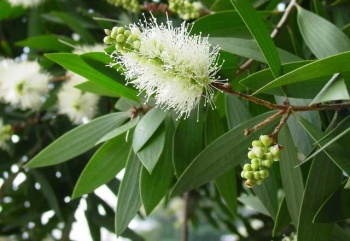Difference between revisions of "Cajeput"
From Wikiwel
(→Special Precautions of Cajeput) |
|||
| Line 1: | Line 1: | ||
| + | [[File:Cajeput.jpg|thumb|Alt=Melaleuca leucadendron|350px|left|Melaleuca leucadendron]] | ||
Other Names : Melaleuca leucadendron, Melaleuca quinquenervia, Melaleuca cajuputi<br> | Other Names : Melaleuca leucadendron, Melaleuca quinquenervia, Melaleuca cajuputi<br> | ||
Cajeput (Melaleuca leucadendron) is a relative to [[Tea Tree]] (Melaleuca alternifolia). | Cajeput (Melaleuca leucadendron) is a relative to [[Tea Tree]] (Melaleuca alternifolia). | ||
Revision as of 12:39, 16 May 2016
Other Names : Melaleuca leucadendron, Melaleuca quinquenervia, Melaleuca cajuputi
Cajeput (Melaleuca leucadendron) is a relative to Tea Tree (Melaleuca alternifolia).
Special Precautions of Cajeput
- Tisserand and Young indicate that due to the 1,8 cineole content, Cajeput Oil may cause CNS and breathing problems in young children.
- Avoid while pregnant.
- May cause skin irritation. Cajuput oil has been classified as non-toxic and non-sensitizing, although skin irritation may occur at high concentrations.
Health Benefits and uses of Cajeput are
Contains up to 60% 1,8-cineole, the main antimicrobial component of the oil .
- Indigenous Australian people used the leaves of this species to treat aches and pains and inhaled vapours from the crushed leaves to treat respiratory infections.
- In Thailand the leaves are used to make a herbal tea as a treatment for a range of medical problems. In many parts of Asia, the oil which gives the tree its name - cajuput oil is used as a liniment and inhalant.
- It has been reported to be useful as an insect repellant, as a sedative and relaxant and is useful in treating roundworms and urino-genital infections.
- Treat asthma, bronchitis, coughs, muscle aches, oily skin, rheumatism, sinusitis, sore throat, spots.
